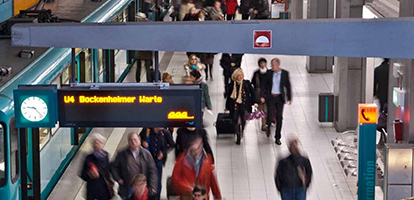

Passenger safety is the central focus for the Frankfurt Transportation Authority (VGF – Verkehrsgesellschaft Frankfurt). This applies not only during travel on their public transportation lines, but also when passengers board and disembark. The fire protection systems in the 27 underground stations is currently being completely overhauled. Fieldbus couplers and I/O modules from the WAGO-I/O-SYSTEM 750 and 753 are playing an important part.
The Frankfurt Transportation Authority (VGF) operates a total of nine subway and ten streetcar lines as the city’s public transportation provider. Around 350 rail vehicles are in service practically around the clock to transport over 160 million passengers annually.
Fire Protection is Crucial
Among the 86 stations associated with the city’s rail network are 27 that are completely underground. This is where fire protection plays an important role, as it does in all buildings where people gather. It must be possible to evacuate the stations in the shortest amount of time in case of emergency. Recently, the VGF fundamentally revised their fire protection design for underground stations. The starting points were corresponding fire protection reports and the integration of the building control system into an overarching concept. The fire alarm systems, which previously functioned autonomously, were to be thereby linked into the building automation for the individual stations.
Siclimat X building control system and SIMATIC-S7 controllers, both from Siemens, are used at the management level and automation level respectively. It is possible for the operators in the central control room to access all subsections in all stations, as well as most of the infrastructure systems. Within the subway stations, a redundant fiber-optic ETHERNET ring networks all the controllers with each other. The fieldbus connections to the individual subsections are implemented using PROFIBUS or PROFINET.
Connecting Inputs and Outputs at the PLC
The fire protection systems are likewise linked to the control room via a PLC. The fire alarm system itself consists of various fire protection elements within each station. The scenario requiring an alarm to sound immediately and evacuation of the station – a train that is already on fire pulls into the station. In this type of situation, different actions need to be implemented simultaneously, which are stored on the PLC as a so-called in case of fire matrix. Thus, the descending escalators are automatically stopped, elevators continue to the highest position and hold, ventilation switches on, optical and acoustic signals prompt the passengers to leave the station, smoke curtains separate various areas of the station in order to prevent the spread of smoke.
Several controllers are incorporated within each station for the individual subsections. In order to connect the inputs and outputs at multiple points, WAGO’s I/O system is used. PROFIBUS or PROFINET couplers are used, depending the part of the control system in which the inputs and outputs are located. According to Rainer Kuhn, who is responsible for converting the automation technology in the subway stations for the VGF, “by using WAGO’s I/O system, we have a suitable I/O module for practically any conceivable signal.” The WAGO components thereby serve almost in the role of data collectors, which detect signals and forward them to the responsible PLC. Even outputs are linked via the I/O system, for example for controlling the voice alarm system.
Monitoring Short Circuits and Cable Breaks
In systems relevant for safety, like fire protection, the controller must be able to monitor signals with perfect functionality. “Before, we calculated a flow resistance and implemented a measurement via an analog input,” explains Kuhn about the old workings of the monitoring system. By using the so-called intruder alarm modules from WAGO, this very expensive solution could be elegantly replaced by a single I/O system bus module. The 753-424 integrates monitoring for cable breaks and short circuits by default, and can therefore easily assume the monitoring of inputs relevant to safety at this point. “The intruder alarm module,” according to the VGF expert, “which integrates all of these functions into a slender module, was one of the primary reason for choosing the WAGO-I/O-SYSTEM.”
The other advantages of the I/O system also easily convinced the VGF. The modular design ensures that a suitable I/O module is available and can be retrofitted for any requirement. The 753 Series I/O modules that are being used in the subway stations also have a pluggable connector, which makes working on the modules significant easier, both during installation and maintenance. The technician removes the connector from the module, executes, for example, a measurement, and then reconnect the connector. Functionality is reestablished with only a few hand movements.
Reliability and Good Advice
In 2006, the VGF began to convert the stations according to the then current fire protection regulations. Rainer Kuhn is convinced that, “we profited greatly from the good advice we received from WAGO employees, especially while planning this system.” Six of the 27 underground stations have been completed up to this point. Around 100 nodes have been equipped with the WAGO-I/O-SYSTEM for this and other projects. An average of ten I/O modules are installed in each node.
Text: Tarak Viol, WAGO
Photo: Klaus Ohlenschläger/vor-ort-foto.de